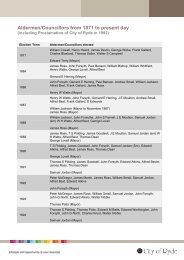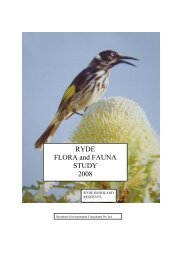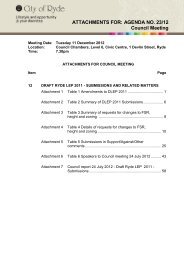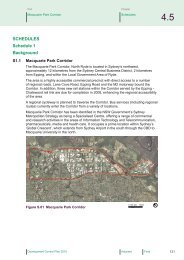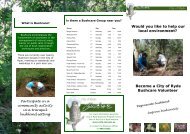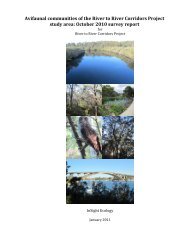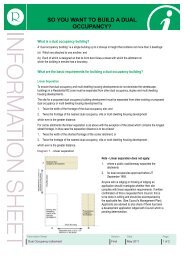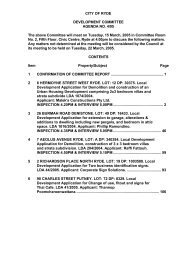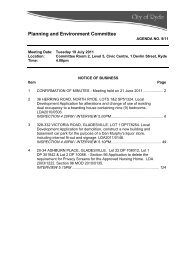RYDE FLORA and FAUNA STUDY 2007 - City of Ryde - NSW ...
RYDE FLORA and FAUNA STUDY 2007 - City of Ryde - NSW ...
RYDE FLORA and FAUNA STUDY 2007 - City of Ryde - NSW ...
Create successful ePaper yourself
Turn your PDF publications into a flip-book with our unique Google optimized e-Paper software.
Biosphere Environmental Consultants Pty Ltd<br />
<strong>Ryde</strong> Flora <strong>and</strong> Fauna Survey <strong>2007</strong> 34<br />
<strong>and</strong> the Burrows Park quadrat (41) contained less than the average <strong>of</strong> 54.5 native plant<br />
species.<br />
Nine quadrats were sampled in this study; five quadrats passed the classification<br />
system while four failed. Three failed quadrats were located in Pembroke Park. The<br />
other was the Pimelea curviflora quadrat in the Field <strong>of</strong> Mars Reserve. While they all<br />
had the required number <strong>of</strong> native species to fulfill the classification requirements,<br />
they were lacking in the required number <strong>of</strong> positive diagnostic species as<br />
summarised in the following table. This decrease in diversity is usually an indication<br />
<strong>of</strong> disturbance to the vegetation community (<strong>Ryde</strong> Flora & Fauna Study, 2006).<br />
Table 6<br />
Diagnostic Plant Species<br />
Quadrat Name Number <strong>of</strong> native Number <strong>of</strong> positive diagnostic<br />
species/required number species/required number<br />
Somerset Rd 69/43 36/28 (+8)<br />
Upper Strangers Creek 69/38 12/11 (+1)<br />
Wolfe Rd 60/39 40/27 (+13)<br />
Pidding Park 60/38 13/11 (+2)<br />
Pimelea curviflora 53/40 16/20 (-4)<br />
Acacia binervia 51/39 25/27 (-2)<br />
Pembroke Park 44/43 18/28 (-10)<br />
Coachwood / Christmas Bush 44/39 21/27 (-6)<br />
Burrows Park 41/33 20/18 (+2)<br />
Of the most diverse quadrats, Somerset Road <strong>and</strong> Wolfe Road are on s<strong>and</strong>stonederived<br />
soil while Upper Strangers Creek <strong>and</strong> Pidding Park are on shale-derived soils.<br />
The Somerset Road quadrat contains S<strong>and</strong>stone Ridgetop Woodl<strong>and</strong>, Wolfe Road is<br />
S<strong>and</strong>stone Gully Forest <strong>and</strong> Upper Strangers Creek <strong>and</strong> Pidding Park contain<br />
Turpentine Ironbark Margin Forest. Fire has no doubt contributed to the high<br />
diversity <strong>and</strong> the high number <strong>of</strong> positive diagnostic species found in the Somerset<br />
Road <strong>and</strong> Upper Strangers Creek quadrat areas. The understorey in both quadrats is<br />
dense with colonising species such as Dodonaea triquetra (Hop Bush) <strong>and</strong> Pimelea<br />
linifolia (Rice Flower) <strong>and</strong> plants in the FABACEAE family. The picture is similar<br />
for the Wolfe Road quadrat, but its fire history is unknown. The fact that the Pidding<br />
Road quadrat straddles the shale/s<strong>and</strong>stone ecotone may explain the high diversity <strong>of</strong><br />
species in that park.<br />
The Pimelea curviflora quadrat in the Field <strong>of</strong> Mars Reserve failed the classification<br />
but there are other positive diagnostic species immediately surrounding the quadrat.<br />
The understorey vegetation here is very different from any found in the whole<br />
reserve: containing the FABACEAE species: Viminaria juncea, Mirbelia rubiifolia<br />
<strong>and</strong> Sphaerolobium vimineum as well as Dianella revoluta var revoluta <strong>and</strong> the<br />
endangered Pimelea curviflora ssp curviflora. Grass species are also plentiful:<br />
Entolasia stricta, Anisopogon avenaceus, Aristida vagans, Austrostipa pubescens,<br />
Dichelachne micrantha, Microlaena stipoides, Themeda australis <strong>and</strong> Eragrostis<br />
brownii. There are also the herbs Laxmannia gracilis, Burchardia umbellata,<br />
Hypericum gramineum <strong>and</strong> Veronica plebeia. The lower than average number <strong>of</strong><br />
positive diagnostic species is most likely due to fragmentation by trail bike riders <strong>and</strong><br />
closeness to the tire trail surrounding the cemetery. Council has recently protected the




